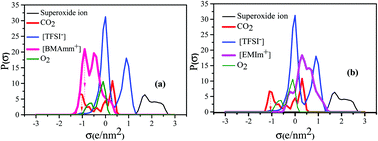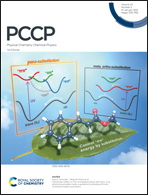Mechanistic insights into carbon dioxide utilization by superoxide ion generated electrochemically in ionic liquid electrolyte†
Abstract
Understanding the reaction mechanism that controls the one-electron electrochemical reduction of oxygen is essential for sustainable use of the superoxide ion (O2˙−) during CO2 conversion. Here, stable generation of O2˙− in butyltrimethylammonium bis(trifluoromethylsulfonyl)imide [BMAmm+][TFSI−] ionic liquid (IL) was first detected at −0.823 V vs. Ag/AgCl using cyclic voltammetry (CV). The charge transfer coefficient associated with the process was ∼0.503. It was determined that [BMAmm+][TFSI−] is a task-specific IL with a large negative isovalue surface density accrued from the [BMAmm+] cation with negatively charged C(sp2) and C(sp3). Consequently, [BMAmm+][TFSI−] is less susceptible to the nucleophilic effect of O2˙− because only 8.4% O2˙− decay was recorded from 3 h long-term stability analysis. The CV analysis also detected that O2˙− mediated CO2 conversion in [BMAmm+][TFSI−] at −0.806 V vs. Ag/AgCl as seen by the disappearance of the oxidative faradaic current of O2˙−. Electrochemical impedance spectroscopy (EIS) detected the mechanism of O2˙− generation and CO2 conversion in [BMAmm+][TFSI−] for the first time. The EIS parameters in O2 saturated [BMAmm+][TFSI−] were different from those detected in O2/CO2 saturated [BMAmm+][TFSI−] or CO2 saturated [BMAmm+][TFSI−]. This was rationalized to be due to the formation of a [BMAmm+][TFSI−] film on the GC electrode, creating a 2.031 × 10−9 μF cm−2 double-layer capacitance (CDL). Therefore, during the O2˙− generation and CO2 utilization in [BMAmm+][TFSI−], the CDL increased to 5.897 μF cm−2 and 7.763 μF cm−2, respectively. The CO2 in [BMAmm+][TFSI−] was found to be highly unlikely to be electrochemically converted due to the high charge transfer resistance of 6.86 × 1018 kΩ. Subsequently, O2˙− directly mediated the CO2 conversion through a nucleophilic addition reaction pathway. These results offer new and sustainable opportunities for utilizing CO2 by reactive oxygen species in ionic liquid media.

- This article is part of the themed collection: Non-traditional solvent effects in organic reactions


 Please wait while we load your content...
Please wait while we load your content...